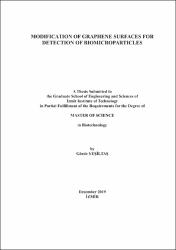Please use this identifier to cite or link to this item:
https://hdl.handle.net/11147/9628Full metadata record
| DC Field | Value | Language |
|---|---|---|
| dc.contributor.advisor | Bulmuş, Volga | |
| dc.contributor.author | Yeşiltaş, Gözde | - |
| dc.date.accessioned | 2020-08-26T07:52:02Z | |
| dc.date.available | 2020-08-26T07:52:02Z | |
| dc.date.issued | 2019-12 | en_US |
| dc.identifier.citation | Yeşiltaş, G. (2019). Modification of graphene surfaces for detection of biomicroparticles. Unpublished master's thesis, İzmir Institute of Technology, İzmir, Turkey | en_US |
| dc.identifier.uri | https://hdl.handle.net/11147/9628 | |
| dc.description | Thesis (Master)--Izmir Institute of Technology, Biotechnology, Izmir, 2019 | en_US |
| dc.description | Includes bibliographical references (leaves: 40-48) | en_US |
| dc.description | Text in English; Abstract: Turkish and English | en_US |
| dc.description.abstract | Pathogens present in the food we consume and the water we drink pose a major threat to human health. Another major health concern is the metastasis of cancer in which cancer cells spread to new areas of the body, often by way of the lymph system or bloodstream. To minimize the burden on health and economy, the detection of biomicroparticles such as pathogens or circulating cancer cells in a highly sensitive and practical manner is higly desirable. This thesis aims to develop a method to create graphene-based biosensor substrate for detection of biomicroparticles such as bacteria, viruses or mammalian cells. For this aim, graphene surface was first functionalized using a linker molecule. The effect of solvent type on functionalization was investigated via Raman spectroscopy and X-Ray spectroscopy (XPS). AntiCD2 antibodies (Ab), as a model antibody, were then conjugated to the functionalized graphene via NHS/EDC chemistry. The Ab conjugation was verified by Raman spectroscopy and XPS analyses. Finally, Jurkat cells, as model biomicroparticles, were recognized and captured by Abconjugated graphene surface, as evidenced by optical microscopy. The temperature, medium, and method for interaction of cells with graphene surfaces as well as the specificity of the Ab- functionalized graphene surface were investigated. The results overall showed the specific and efficient recognition of model cell line by Abconjugated graphene surfaces. | en_US |
| dc.description.abstract | Tükettiğimiz yiyeceklerde ve içtiğimiz sularda bulunan patojenler insan sağlığı için büyük bir tehdit oluşturmaktadır. Bir diğer önemli sağlık sorunu, kanser hücrelerinin genellikle lenf sistemi veya kan dolaşımı yoluyla vücudun yeni bölgelerine yayıldığı kanser metastazıdır. Sağlık ve ekonomi üzerindeki yükü en aza indirmek için, patojenler veya dolaşımdaki kanser hücreleri gibi biyomikropartiküllerin oldukça hassas ve pratik bir şekilde saptanması talep edilen bir durumdur. Bu tez, bakteri, virüs veya memeli hücresi gibi biyomikropartiküllerin tespiti için grafen esaslı biyosensör substratı oluşturmak için bir yöntem geliştirmeyi amaçlamaktadır. Bu amaçla grafen yüzey ilk olarak bir bağlayıcı ara molekül kullanılarak fonksiyonelleştirildi. Çözücü tipinin grafen yüzey fonksiyonelleştirilmesi üzerindeki etkisi Raman spektroskopisi ve X-Ray spektroskopisi (XPS) ile araştırıldı. Daha sonra bir model antikor olarak AntiCD2 antikorları (Ab), NHS / EDC kimyası yoluyla fonksiyonelleştirilmiş grafen yüzeye konjüge edildi. Ab konjugasyonu Raman spektroskopisi ve XPS analizleriyle tespit edilmiştir. Son olarak, model biyomikropartiküller olarak kullanılan Jurkat hücreleri, Ab ile konjuge grafen yüzeyi tarafından tanındı ve hücre-yüzey etkileşimi optik mikroskopi ile kanıtlandı. Hücrelerin grafen yüzeyleri ile etkileşimi için sıcaklık, ortam ve yöntem ile Abfonksiyonel grafen yüzeyinin özgüllüğü araştırıldı. Sonuçlar genel olarak Abkonjuge grafen yüzeyler tarafından model hücre hattının spesifik ve etkili bir şekilde tanınmasını gösterdi. | en_US |
| dc.description.sponsorship | TUBITAK (117F186) | en_US |
| dc.format.extent | xi, 48 leaves | |
| dc.language.iso | en | en_US |
| dc.publisher | Izmir Institute of Technology | en_US |
| dc.rights | info:eu-repo/semantics/openAccess | en_US |
| dc.subject | Biomicroparticle | en_US |
| dc.subject | Biosensors | en_US |
| dc.subject | Graphene | en_US |
| dc.subject | Antibody | en_US |
| dc.subject | Cell capture | en_US |
| dc.title | Modification of graphene surfaces for detection of biomicroparticles | en_US |
| dc.title.alternative | Biyomikropartiküllerin belirlenmesi için grafen yüzeylerin modifikasyonu | en_US |
| dc.type | Master Thesis | en_US |
| dc.institutionauthor | Yeşiltaş, Gözde | - |
| dc.department | Thesis (Master)--İzmir Institute of Technology, Bioengineering | en_US |
| dc.relation.tubitak | info:eu-repo/grantAgreement/TUBITAK/MFAG/117F186 | |
| dc.relation.publicationcategory | Tez | en_US |
| item.languageiso639-1 | en | - |
| item.fulltext | With Fulltext | - |
| item.openairecristype | http://purl.org/coar/resource_type/c_18cf | - |
| item.openairetype | Master Thesis | - |
| item.grantfulltext | open | - |
| item.cerifentitytype | Publications | - |
| Appears in Collections: | Master Degree / Yüksek Lisans Tezleri | |
Files in This Item:
| File | Description | Size | Format | |
|---|---|---|---|---|
| 10189746.pdf | MasterThesis | 1.46 MB | Adobe PDF |  View/Open |
CORE Recommender
Page view(s)
228
checked on Jul 22, 2024
Download(s)
178
checked on Jul 22, 2024
Google ScholarTM
Check
Items in GCRIS Repository are protected by copyright, with all rights reserved, unless otherwise indicated.